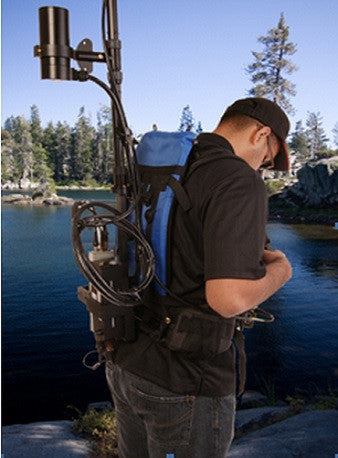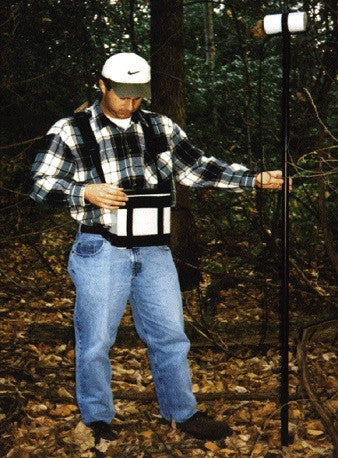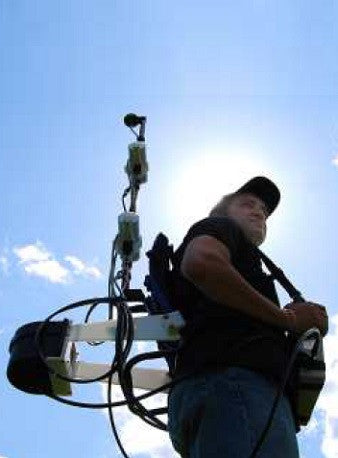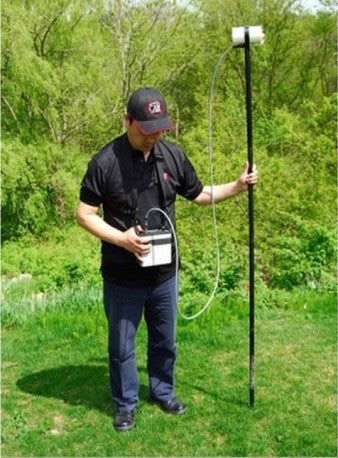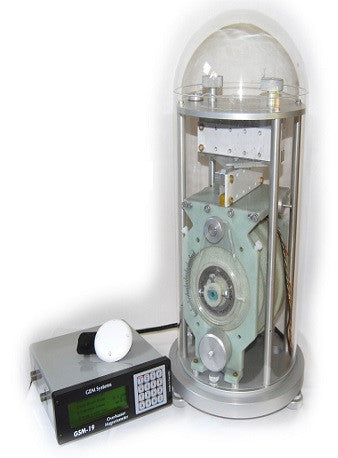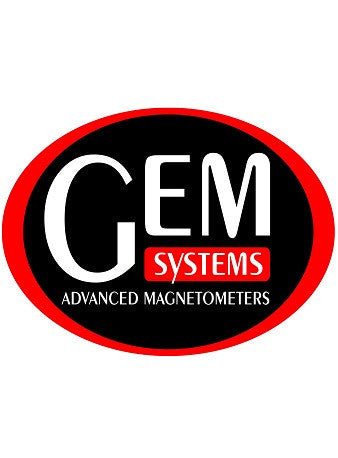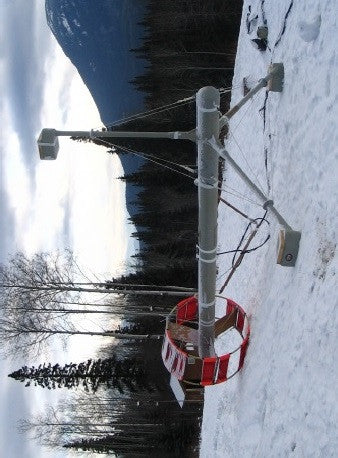Ultra Sensitive Potassium Magnetometer - GSMP-35/40
Supplied By: GEM Systems, Canada
Rs. 0.00
Mineral Exploration
At the pinnacle of GEM offerings is the Potassium magnetometer/gradiometer system. The GSMP-35 ground system is the highest sensitivity instrument for subsurface investigations in numerous fields, including, but not limited to, mineral prospecting and exploration, oil & gas exploration, UXO detection and discrimination, and environmental & engineering.
The system is designed for clients who require the absolute maximum in data quality – exceeding that of conventional Cesium Magnetometer devices by an order-of-magnitude, or more! Data quality is driven by sensitivity, minimal heading error, high absolute accuracy, no microphone, and overall design. Unlike its cesium magnetometer cousin, Potassium offers a thin spectral line of operation – meaning that there are fewer drop-outs and errors during surveying. In the event of a drop-out, it is easy to spot in Potassium magnetometers unlike cesium magnetometers.
Potassium was a joint development between GEM and a Russian research institution – this collaboration has led to the absolute supremacy of this instrument for subsurface mapping.
Ultra-High Sensitivity Mapping
Many subsurface targets have subtle signals that can only be detected with an ultra-sensitive magnetometer/gradiometer. These targets include gold deposits with subtle shear and fracture zones, archaeological artifacts, and subtle anomalies.
High data quality is assured through the GSMP-35 magnetometer’s ultra-high sensitivity, accuracy, gradient tolerance and minimal heading error. Sensitivity is 0.0003 nT @ 1Hz with Accuracy ± 0.05nT - highest in the industry. This makes the system effective for mapping subtle anomalies and structures in resource exploration applications. Ultra-sensitivity also gives the confidence to detect and characterize hidden targets with precision and confidence. It is a new era in magnetometry with the GSMP-35.
The instrument also has a gradient tolerance of 50,000 nT/m, making it ideal for mapping highly ferrous geological units such as iron outcrops encountered in mineral exploration. In addition, the system has the lowest heading (orientation) error, thereby resulting in the cleanest magnetic readings possible
Fast-Sampling
The Potassium magnetometer has a maximum sampling frequency of 20 Hz (along with other, selectable sampling rates). This sampling gives amazing functionality for performing automated surveys. These are surveys in which clients use various platforms, such as all-terain-vehicles, sleds, bicycles, etc., to make measurements at a relatively rapid speed – 5 to 10 km per hour.
This kind of coverage gives a huge advantage for large (and smaller) surveys – offering very efficient surveying at minimal cost.
‘Flavours’ of Potassium Magnetometers
Because of its design and physics, the GSMP-35 can be used in several different “flavours”. In magnetometer mode, the system comes with a single ultra-high sensitivity sensor and electronics. This configuration is doubled up for gradiometers – which unlike other products on the market – offer true simultaneous readings for highly accurate gradient maps and interpretations.
The system is also available as a “high-fields” magnetometer/gradiometer system, capable of recording extremely high fields that occur over iron deposits and potentially within city limits where noise is pervasive. This version is referred to as the “Iron-Mag” and is unique to GEM.
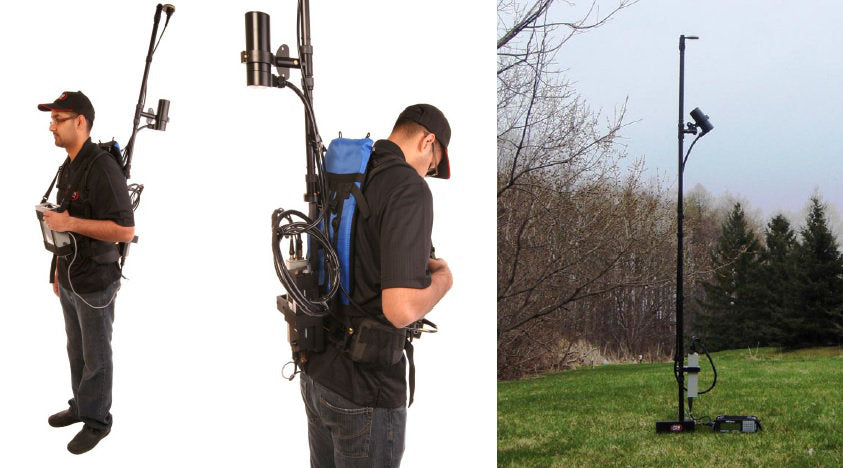
Specifications
Performance
-
Sensitivity: 0.0003nT @ 1Hz
-
Resolution: 0.0001nT
-
Absolute Accuracy: ± 0.05 nT
-
Range: 15,000 to 120,000 nT or 5,000 to 350,000 nT
-
Gradient Tolerance: 50,000 nT/m
-
Samples at: 1, 5, 10, 20 Hz
-
Operating Temperature: -40°C to 55°C
Orientation
-
Sensor Angle: Optimum angle 30° between sensor head axis and field vector
-
Orientation: 10° to 80° and 100° to 170°
-
Heading Error: ± 0.05 nT @360° full rotation about axis
Storage (# of Readings)
-
Magnetometer: 3,303,000
-
Gradiometer: 2,359,000
-
Base Station: 8,257,000
Environmental
-
Operating Temperature: -40°C to 55°C
-
Storage Temperature: -70°C to 55°C
-
Humidity: 0 to 100%, splash proof
Dimensions and Weights
-
Console: 223x69x240mm
-
Sensor: 148x64mm cylinder type; 1.0Kg
-
Electronic Box: 229mm x 56mm x 39mm; 0.63Kg
Power
-
Power Supply: 22 to 32VDC
-
Power Consumption: 0.5 amp typical at 20°C
-
Warm up Time: < 10 min. at 20°C
Outputs
-
UTC Time
-
Magnetic Field
-
Lock Indication
-
Heater
-
Field Reversal
-
Latitude and Longitude
-
GPS Altitude
Standard Components
-
Console
-
GEMLinkW Software
-
Electronic Box
-
Backpack
-
25,9V 4Ah Lithium Battery
-
Harness
-
Charger
-
Sensor with Cable
-
RS-232 Cable and USB adapter
-
Staff
-
Instruction Manual and Shipping Case

Features and Benefits
The new Potassium system Magnetometer has the highest sensitivity and absolute accuracy. It is designed for ground applications where data quality, cost control and ruggedess are key for project success.
Value adding features:
-
Highest Sensitivity available at 0.0003nT @ 1Hz
-
Gradient Tolerance of 50,000 nT/m
-
Fast sampling up to 20Hz; ideal for high resolution surveys
-
Integrated Backpack; convenient and high productivity
-
Low power consumption - Up to 16 hours of continuous operation per charge
-
Light weight and compact design
-
Two GPS Options available
Standard GPS Option B: 0.7 SBAS (WAAS, EGNOS, MSAS)
High Resolution Option D:
0.6 SBAS (WAAS, EGNOS, MSAS)
0.6 OmniStar (VBS2 subscription) -
Easy to use mapping and navigation capabilities for enhanced survey performance
-
Proven reliability based on 28 years of R&D
Cost Control
In the past five years, industry rationalization has resulted in a greater emphasis on increasing productivity of surveying. WIth the new Potassium Magnetometer, the emphasis is also on cost control, through the following features:
-
Display: Easy to ready display with specific settings for presenting real time data on console
-
Navigation/GPS: The industry's most versatile precise navigation technology for surveying without cutting grids for significant cost savings
-
Import: Streamlined import of maps for georeferenced walking surveys
-
High Capacity Memory: 3,000,000 readings without concern for memory space or the need to dumo memory during the survey
Ruggedness
Resource exploration often requires travelling to remote locations and operating instruments in less than ideal conditions (heat, cold, damp, etc.).
The new Potassium Magnetometer has excellent environmental specifications as well as other capabilities that contribute to robustness. These include rugged packaging on an ergonomic back-pack, and robust sensors, the main component of any magnetometer system.
Integrated GPS
Integrated GPS is a huge development. Not only do our GPS technologies tell you where you have been, but they tell you where you need to go. This allows for highly accurate readings via ‘Waypoint Programming’ as well as for base station corrections.
With Waypoints, you design your survey on your personal computer and import the stations with ease into the magnetometer console. Then, the system will guide you to each Waypoint where a reading is to be made. With ‘Walking’ mode, you have a nearly continuous record of GPS-referenced data points – a major advantage in surveying because you save time in the field and it eliminates the possibility of positioning mistakes.
Advancing the Field of Potassium Magnetometry
GEM's R&D programs continue to advance the frontiers of Magnetometry.
Recent developments in small sensor design have increased gradient tolerance by five times while maintaining the industry standard in sensitivity and absolute accuracy.
At GEM, the work in delivering the most advanced and reliable products continues everyday.
GSMP-40 Optically Pumped Potassium Magnetometer & Gradiometer

GEM is unique as the only commercial supplier of Potassium systems - the highest sensitivity and absolute accuracy optically pumped Magnetometers available. The new GSMP-40 extends these characteristics to the next generation of even higher performing instruments
Major Benefits of the GSMP-40 Magnetometer and Gradiometer:
-
Acquisition of very high resolution and accuracy data. Potassium systems are substantially more sensitive than other optically pumped Magnetometers and Gradiometers
-
Location of very weak magnetic objects or small-size anomalies. This is a key requirement in applications, such as UXO/EOD and archaeology, where success depends on the ability to map and characterize the smallest contrasts in magnetic physical properties
-
High quality results in areas with high gradients. GEM's small diameter (40mm) sensors optimize magnetic measurements for sensitivity and gradient tolerance
-
Proven reliability and predictability of results. The natural physics of Potassium narrow line spectra minimizes heading and orientation errors to negligible levels
-
Minimization of maintenance costs. Once a system is purchased, there is no need to return it for periodic optical alignment. This significantly reduces servicing and shipping costs over the lifetime of an instrument
-
Enhanced survey efficiency. The GSMP-40 minimizes operating requirements, such as warm up and lock times, that slow surveys down
-
Fast response to changing magnetic fields - for moving and stationary work
Other Benefits of the GSMP-40 Magnetometer and Gradiometer:
A different approach to optically pumped technology
Some of the principles of GEM's optically pumped Potassium Magnetometers are similar to other optically pumped systems, the Potassium approach differs significantly in terms of the underlying physics. The differences is that Potassium is characterized by widely spaced, non overlapping spectral lines. Spectral lines provide the basis for measurement in all optically pumped systems.
From an instrument perspective, narrow, non-overlapping spectra provides a number of benefits:
-
Enables the electrons to easily lock on a predefined spectral line. This translates into very high sensitivity and maximum bandwidth (the "size" of geophysical features that can be resolved with the system)
-
Minimal heading errors. Errors occur due to variation in alignment of the sensor head in the magnetic field. With Potassium errors are less than 0.1 µT. With other optically pumped systems, the heading error is 1-2 nT and can overwhelm the real magnetic response
-
Reductions in heading errors translate into improved gradient measurements. The GSMP-40 does not introduce orientation "noise" into measurements. The result is that the gradient measurements are very high quality in dynamic and static environment
-
All of these technologies come complete with the most attractive savings and warranty in the business!
Features of GSMP-40 Magnetometer and Gradiometer
THe GSMP-40 is the highest sensitivity and absolute accuracy Magnetometer/Gradiometer available. It is designed for mobile application with the most demanding survey specifications
-
Data export in standard XYZ format for easy use in standard software programs
-
Programmable export for full output control
-
GPS elevation values for input into geophysical modelling routines
-
Enhanced GPS positioning resolution:
<1.5m standard GPS for high resolution surveying
<1.0m OmniStar GPS
<0.7m for newly introduced CDGPS -
Multi sensor capability for advanced surveys to resolve target geometry
-
Picket & line marking / annotation for capturing related surveying information on-the-go
Specifications of GSMP-40
Performance
-
Sensitivity: 0.0025nT RMS @ 1Hz
-
Resolution: 0.0001nT
-
Absolute Accuracy: ± 0.1 nT
-
Dynamic Range: 20,000 to 100,000 nT
-
Gradient Tolerance: 13,500 nT/m
-
Sampling Rate: 1, 5, 10, 20 Hz
Operation
-
Sensor Angle: Optimum angle 30° between sensor head axis and field vector
-
Orientation: 10° to 80° and 100° to 170°
-
Heading Error: ± 0.05 nT @10° to 80° and 360° full rotation about axis
Environmental
-
Operating Temperature: -20°C to 55°C
-
Storage Temperature: -70°C to 55°C
-
Humidity: 0 to 100%, splash proof
Dimensions and Weights
-
Sensor: 141mm x 64mm (external dia); 1.5 Kg
-
Electronic Box: 229mm x 56mm x 39mm; 0.63Kg
Power
-
Power Supply: 22 to 32VDC
-
Power Consumption: 0.5 amp typical at 20°C
-
Warm up Time: < 10 min. at 20°C
Outputs
-
Cycled Total Field readings with position & time as digital readout
-
Graph form on the console
-
ASCII format via an RS-232 COM port
-
Pre-amplifier outputs are continuous signals at the Potassium Larmor frequency, which are proportional to the magnetic field (7 Hz/nT)
Standard Components
-
GSMP-40 Console
-
GEMLinkW Software
-
Electronic Box
-
Harness
-
29.6V Lithium Battery belt
-
Charger
-
Sensor with Cable
-
RS-232 Cable
-
Pole Assembly
-
Instruction Manual and Shipping Case
Theory of Operation
The GSMP-35/40 uses a cell containing Potassium vapour. Electron precession frequency is obtained from a single spectral line allowing for highest sensitivity and absolute accuracy in comparison with other competing products. Potassium does not “wander” across spectra as cesium does, which results in minimal “drop-outs” and overall better quality data.
A typical alkali vapour magnetometer consists of a glass cell containing an evaporated alkali metal (i.e. alkali atoms). According to quantum theory, there is a set distribution of valance electrons within every population of alkali atoms. These electrons reside in two energy levels as represented by the numbers 1 and 2 in the figure below.

Light of a specific wavelength is applied to the vapour cell to excite electrons from level 2 to 3 only. This process of polarization reduces the number of atoms with electrons at level 2.
Electrons at level 3 are not stable and spontaneously decay back to levels 1 and 2. Eventually, level 1 becomes fully populated and level 2 is fully depopulated. The result is that the cell stops absorbing the light and turns from opaque to transpaernt.
At this point, RF de-polarization comes into play. Here, we apply RF power of a wavelength that corresponds to the energy difference between levels 1 and 2 to move electrons from level 1 back to level 2.
The significance of de-polarizatuon is that the energy difference between levels 1 and 2 (i.e. the frequency of the RF depolarization field - larmor frequency) is directly proportional to the magnetic field.
In the process of polarization and depolarization, light is modulated by Larmor frequency. Light modulation is detected and the frequency value is then converted to magnetic field units.
Related Products

